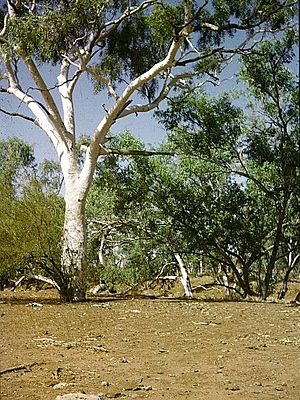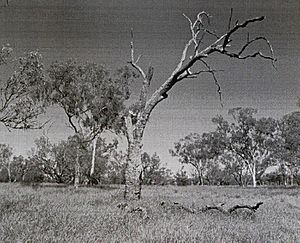Moonah Creek Hanging Tree facts for kids
Quick facts for kids Moonah Creek Hanging Tree |
|
|---|---|

Moonah Creek Hanging Tree, 1964
|
|
| Location | Ardmore Station, Waverley, Shire of Boulia, Queensland, Australia |
| Design period | 1870s - 1890s (late 19th century) |
| Official name: Moonah Creek 'Hanging Tree', Killing Tree; Butchering Tree | |
| Type | state heritage (landscape) |
| Designated | 8 September 2005 |
| Reference no. | 600040 |
| Significant period | 1890s- (social ) 1890s-1900s (historical) |
| Significant components | tree |
| Lua error in Module:Location_map at line 420: attempt to index field 'wikibase' (a nil value). | |
The Moonah Creek Hanging Tree is a special heritage-listed tree in Queensland, Australia. It stands on Ardmore Station, near Waverley. This tree is also known by other names like the Killing Tree or Butchering Tree. It was added to the Queensland Heritage Register on 8 September 2005 because of its important history.
Contents
What is the Moonah Creek Hanging Tree?
This tree is a type of Ghost Gum (its scientific name is Corymbia papuana). It grows near the bank of Moonah Creek. It is also close to the road that connects Urandangi to the Diamantina Developmental Road. The tree is located on a piece of land called Oban Holding.
A Difficult Past: Oral History
Local Aboriginal communities in Queensland's northwest have a strong oral history about this tree. Oral history means stories passed down through generations by speaking, not writing. These stories say that around the late 1800s or early 1900s, this tree was a site of a very sad event. It is believed that local police were involved in a conflict with Aboriginal people here. The Waluwarra people are the traditional owners of this area.
While there are no old written records to confirm all the details, the local Aboriginal people strongly believe this event happened. They see the tree as a reminder of the difficult and sometimes violent history between settlers and Aboriginal people. This history involved disagreements over land and resources.
Life on the Land: Early Conflicts
The area around Oban Holding, known as the Barkly Tableland, has been used for raising cattle since the 1870s. As more settlers arrived, there were often conflicts between them and the Aboriginal people. Both groups needed the land and its resources. These disagreements were especially common in the 1880s.
Oral history from the Waluwarra Aboriginal Corporation shares many stories about the incident at the tree. It tells of police and Aboriginal trackers gathering Aboriginal people. The stories suggest that the tree was used in a tragic way as a result of these conflicts.
Was it a Butchering Tree?
Some people also think the Moonah Creek tree might have been used for butchering cattle. A "killing tree" or "butchering tree" was common on many cattle properties. These trees had a strong timber beam tied into a fork or cut into the tree trunk. This beam was used to hang animals for butchering. Sometimes, the tree would grow around the beam over time.
In 1984, the tree was added to the National Trust of Queensland's Register of Significant Trees. This was because of its connection to the stories of Aboriginal people. A person who nominated the tree described it as a beautiful Ghost Gum. They noted that the tree had grown around a timber beam, which was clearly visible in 1964.
What Does the Tree Look Like Now?
The Moonah Creek Hanging Tree is a Ghost Gum, known for its whitish bark. It stands about 10 meters (about 33 feet) from Moonah Creek. The area around it has grasses, Gidgee Gums, other Ghost Gums, and Coolibahs.
A report from March 2003 stated that the tree was no longer alive. It was about eight meters (about 26 feet) tall. Two of its four main branches had fallen off. The branch that held the "gallows beam" had also fallen and was broken on the ground. The beam itself was missing. The tree trunk had a lot of damage from termites and a large crack.
Why is This Tree Important?
The Moonah Creek Hanging Tree was listed on the Queensland Heritage Register on 8 September 2005. This means it is very important for several reasons:
- It shows how Queensland's history developed. The tree is a reminder of the early days of settlement. It shows the challenges and conflicts that happened as different groups of people lived on the land.
- It has a strong connection to a community or cultural group. The tree is very important to the local Aboriginal community, especially the Waluwarra nation. They believe the tree is a "conflict site." This means it represents the difficult and sometimes violent history of how settlers and Aboriginal people interacted in Queensland. Even though there isn't written proof of all the events, the local Aboriginal people are sure the events happened. The tree holds strong historical and social value for them and the wider community.


